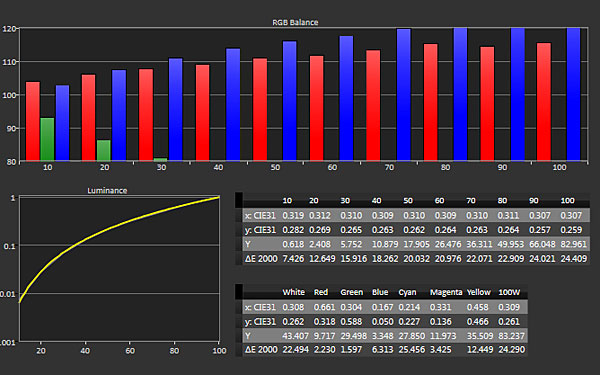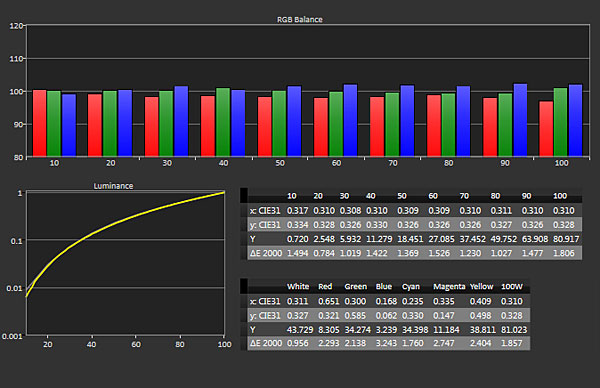3K? For 92 inches? I can get an 80 inch 4K regular TV for 1200. I spent 7K (more like 14K today) for a projector the fill my 120 inch screen 20 years ago, but today, why? When TLC will soon give you a hundred inch TV for less then the 3K here, with all the brightness and contrast, I see the day of the projector as dead. I have seen 50K systems with Swiss glass lenses on a 150 inch screen that look great, but that is not for most people. A projector in the future is only going to be ultra high end huge screens or a system in a space where you can't get a TV into it, like down a twisting stair well. And even then, how far off are roll up TVs from being real?
LG HU810PW 4K Laser DLP Projector Review Test Bench
FULL-ON/FULL-OFF CONTRAST RATIO: 3,225:1
The measurements here were made using Calman measurement software from Portrait Displays (www.portrait.com), together with a Photo Research PR- 650 color meter, Minolta LS-100 luminance meter and a Murideo/AVPro (Fresco Six-G) test pattern generator.
Pre-calibration measurements were made with the LG HU810PW's Expert (Dark Room) picture mode active. Post-calibration measurements were made in the same mode. All measurements were made with the projector positioned at a 14-foot distance from a 92-inch diagonal, 1.1 gain Stewart Filmscreen Cima screen.
The projector's maximum full-on/full-off SDR contrast ratio was achieved with the Expert (Dark Room) Picture, Minumum Energy Saving, Dark Room Iris, Low Black Level, High Dynamic Contrast, and Adaptive Contrast settings active, with Contrast at 80 and Brightness at 50. With this combination, black measured 0.006 ft-L and peak white 19.35 ft-L for a contrast ratio of 3,225:1. With the Iris set to Medium, contrast ratio with the other settings listed above was 2,415:1.


Before calibration, the default color temperature preset in Expert (Dark Room) Picture mode displayed a significant red/blue bias. The Delta E averaged 18.85, with a low of 7.4 at 10 IRE and a high of 24.4 at 100 IRE. After calibration, the average Delta E improved dramatically to 1.3 with a high of 1.8 at 100 percent brightness. (Delta E is a figure of merit indicating how close the color comes to the standards, either D65 for the white point or the color coordinates for each of the primary and secondary colors that define the color gamut under test. Values below 3 are generally unnoticeable.)
With the default settings active in Expert (Dark Room) Picture mode, the Delta E of the HU810PW's measured color points averaged out to 8.5. Using the projector's color management system adjustments, I was able to improve color point accuracy to an average Delta E of 2.4, with a high of 3.2 for blue. Coverage of the DCI-P3 color gamut in Expert (Dark Room) mode topped out at 87.3 percent.
Post-calibration, gamma closely tracked a 2.2 target for most of the range with the BT.1886 Gamma preset selected. With the HDR Cinema Home preset mode active, peak white output measured 110 nits +/- 5 nits regardless of the size of the measured white window. Picture uniformity was excellent: white full- field test patterns showed minimal brightness drops between the center and edges of the projection screen, and no color shifts. Our suite of video processing tests revealed excellent all-around performance.
Fan noise is very low. LG specs it at 28dB for Minimum Energy Saving, and I only measured a 2dB difference between the Minimum and Maximum modes.
Input lag with a 1080p source measured 80ms in Game mode, making the LG a below-average option for high-def gaming.—A.G.
Note: The Where to Buy link below is an affiliate link. If you purchase through the link, we may earn a small commission at no extra cost to you. Thank you for your support!
- Log in or register to post comments





































































